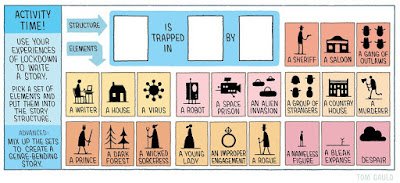Week 10 assignments. Remember: all the Week 10 assignments are available in Canvas as extra credit, so if you have work you missed in previous weeks, you can use those Week 10 assignments as make-up work. Here is a link to the Week 10 schedule as usual, plus the calendar for future weeks.
Progress chart. If you are trying to figure what you might need to do during Week 10, you can use this progress chart to see if you are on track for the grade you want in the class and/or if you want to finish early. As always, just let me know if you have any questions about that.
Projects. Over the weekend, I'll update the stack with any projects that come in, so you can check the stack to make sure I received your form.
The following items are for fun and exploration:
Holy Saturday. The Saturday before Easter is traditionally remembered as the day when, after his death, Jesus descended into Hell in order to rescue Satan's captives there, including the patriarchs and other characters from the Bible, including Adam and Eve. You can read about this legend at Wikipedia: Harrowing of Hell. Here is a 12th-century illustrated manuscript that shows the gate of Hell as the mouth of a gigantic beast; Jesus, helped by an angel, is freeing the captives:
April 12: Easter Sunday. Do you know the Eastern legend of the dogwood? This is the time of year when the dogwoods bloom. Here's the legend:
The dogwood tree was once as tall and strong as an oak, and the wood of the mighty dogwood tree was used for the cross of Jesus. The dogwood grieved to be used for such a purpose, so Jesus took pity on the dogwood. From then on, the dogwood tree became short and twisted so that its wood could never again be used to make a cross, and the dogwood flowers represent the Crucifixion, with the four white petals in the shape of a cross.
You can read more about this Easter legend at Wikipedia, which is also the source for this image:

The dogwood tree was once as tall and strong as an oak, and the wood of the mighty dogwood tree was used for the cross of Jesus. The dogwood grieved to be used for such a purpose, so Jesus took pity on the dogwood. From then on, the dogwood tree became short and twisted so that its wood could never again be used to make a cross, and the dogwood flowers represent the Crucifixion, with the four white petals in the shape of a cross.
You can read more about this Easter legend at Wikipedia, which is also the source for this image:

Blog stream. Instead of a blog post item, I am sharing a video: it's Maya's recital from this weekend! You can find out more about Maya at her blog, and here is the recital video. So wonderful! I wasn't able to get the embedding to work, but here's a screenshot, and you can use this link to watch and listen. :-)
Plus to set the mood for break, here is a cat basking on Russian historical novels:
I think I might have shared this before, but it came around on Twitter again, so I'm sharing it here: Goodnight, Zoom. (larger version)
Plus a flowchart for better time management:
Finally, something from Crash Course: Freud, Jung, Luke Skywalker, and the Psychology of Myth.
April Fools' Day. There are great hoaxes and pranks every year for April Fools' day, and one of my all-time favorites is the "flying penguins" hoax from the BBC back in 2008. You can watch the video at YouTube: don't believe everything you see! You can find out more about April Fools' Day at Wikipedia.
And there's a project in the Myth-Folklore class today which has April Fools' as its setting: it's Chris's trickster project, The Best Trickster.









